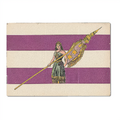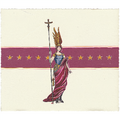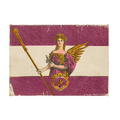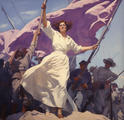Aurelia: Difference between revisions
No edit summary |
|||
| (19 intermediate revisions by the same user not shown) | |||
| Line 2: | Line 2: | ||
{{CitizenAW | {{CitizenAW | ||
| Photo = File:AureliaFirstPostcard1686AN.png | | Photo = File:AureliaFirstPostcard1686AN.png | ||
| Caption = ''The first documented appearance of Aurelia, in a postcard commemorating the creation of the Federation of [[Alduria-Wechua]]; by [[Cecilia Dennison]]; {{AN| | | Caption = ''The first documented appearance of Aurelia, in a postcard commemorating the creation of the Federation of [[Alduria-Wechua]]; by [[Cecilia Dennison]]; {{AN|1685}}.'' | ||
| Titles and Offices = Personification of [[Nouvelle Alexandrie]] | | Titles and Offices = Personification of [[Nouvelle Alexandrie]] | ||
| FullName = Aurelia of Nouvelle Alexandrie | | FullName = Aurelia of Nouvelle Alexandrie | ||
| Line 42: | Line 42: | ||
===Name=== | ===Name=== | ||
The name "Aurelia" is derived from the [[Audente]] word "aureus," meaning "golden". During the development of Aurelia, several other names were considered, such as Margarita, Lady Fenix, among others. The name "Aurelia" was eventually chosen by the [[Arts and Culture Commission of Nouvelle Alexandrie|Arts and Culture Commission]], because it was seen to evoke a sense of worth, brilliance, and enduring value. This name was selected to signify a new era of prosperity and enlightenment for both [[Alduria]] and the [[Wechua Nation]]. The name also acts as both a reference to the vast wealth and riches of [[Alexandria]], which for centuries dominated the large gold deposits in [[Cibola]], and to the legacy of Aurelia's father, the god [[Faith of Inti|Inti]] himself. In this context, the name Aurelia not only a reference to historical and cultural legacies, but it also is meant to symbolize a bright, prosperous future. | The name "Aurelia" is derived from the [[Audentior|Audente]] word "aureus," meaning "golden"<ref>“Jill Scott - Golden.” YouTube, YouTube, 13 Aug. 2007, [http://www.youtube.com/watch?v=4QCXr79Rkcw www.youtube.com/watch?v=4QCXr79Rkcw].</ref>. During the development of Aurelia, several other names were considered, such as Margarita, Lady Fenix, among others. The name "Aurelia" was eventually chosen by the [[Arts and Culture Commission of Nouvelle Alexandrie|Arts and Culture Commission]], because it was seen to evoke a sense of worth, brilliance, and enduring value. This name was selected to signify a new era of prosperity and enlightenment for both [[Alduria]] and the [[Wechua Nation]]. The name also acts as both a reference to the vast wealth and riches of [[Alexandria]], which for centuries dominated the large gold deposits in [[Cibola]], and to the legacy of Aurelia's father, the god [[Faith of Inti|Inti]] himself. In this context, the name Aurelia not only a reference to historical and cultural legacies, but it also is meant to symbolize a bright, prosperous future. | ||
<gallery widths=180px perrow=5 caption="Examples of Famous Depictions of Aurelia"> | |||
File:AureliaFirstPostcard1686AN.png|<center>"Lady Aurelia", the first known depiction of Aurelia, drawn by [[Cecilia Dennison]]. Became a wildly successful and popular postcard that introduced Aurelia to the country.<br>({{AN|1686}}).</center> | |||
File:EmpressAureliaNAX1698.png|<center>"Empress Aurelia, Salvanos", a postcard drawn by [[Cecilia Dennison]] celebrating the (then) [[Administrative divisions of Nouvelle Alexandrie|10 Regions]] of [[Nouvelle Alexandrie]].<br>({{AN|1698}})</center> | |||
File:VintageAurelia1699.png|<center>"Lady Aurelia with the Wings of the Phoenix", a postcard drawn by [[Cecilia Dennison]]. This was meant to reference her first postcard, but showing Aurelia as a ruler.<br>({{AN|1699}})</center> | |||
File:AureliaDeLosEjercitosDeGloria.png|<center>"La Aurelia de los Ejercitos de Gloria" ("Aurelia of the Armies of Glory"), painted by Pedro de la Garza around the time of [[Operation Purple Splendor]].<br>({{AN|1718}})</center> | |||
File:AureliaLegislativePalace.png|<center>An untitled painting in the [[Legislative Palace]] depicting Aurelia; by Casimiro Montesinos.<br>({{AN|1699}})</center> | |||
File:AureliaDeTodos1731.png|<center>"Aurelia de Todos", a large sculpture located at the [[Parque de los Niños]] in [[Parap]], [[Wechua Nation]]. The child represents the children of the federation; by Alejandro Venegas.<br>({{AN|1697}})</center> | |||
File:AureliaGuidingTheNation1710.png|"Aurelia Guiding the Nation", painted by George Vauban-Lloyd.<br>({{AN|1710}})</center> | |||
File:BustofAureliaPuntaSantiago1728.png|"La Mujer de Oro", a bust of Aurelia by Gery Balsdenberg representing the prosperity and industriousness of the federation.<br>({{AN|1728}})</center> | |||
File:GoToLyrica1703AN.png|<center>"Go To Lyrica, Young Man - Follow Her!", a propaganda poster by Louis Xavier featuring Aurelia, promoting the [[New_Prosperity_Plan#Territorial_expansions|Lyrican Settlement Company]] and its efforts to settle in the new Regions of [[North Lyrica]] and [[South Lyrica]].<br>({{AN|1703}})</center> | |||
File:RiseToHerDefense1719.png|<center>"Rise to Defend Her!", a military recruitment poster by Louis Xavier featuring Aurelia.<br>({{AN|1719}})</center> | |||
</gallery> | |||
==Role in Society== | ==Role in Society== | ||
===HMS Aurelia=== | |||
{{Main|HMS Aurelia}} | |||
==Cultural Impact== | ==Cultural Impact== | ||
| Line 55: | Line 70: | ||
*[[Alejandro Campos]] | *[[Alejandro Campos]] | ||
*[[Manco Capac|King Manco Capac I]] | *[[Manco Capac|King Manco Capac I]] | ||
*[[Symbols of Nouvelle Alexandrie]] | |||
*[[HMS Aurelia]] | |||
==References== | |||
{{reflist}} | |||
[[Category:Nouvelle Alexandrie]] | [[Category:Nouvelle Alexandrie]] | ||
[[Category:Culture of Nouvelle Alexandrie]] | [[Category:Culture of Nouvelle Alexandrie]] | ||
[[Category:Symbols of Nouvelle Alexandrie]] | |||
Latest revision as of 08:07, 7 December 2024

|
This article or section is a work in progress. The information below may be incomplete, outdated, or subject to change. |
Who's Who of Nouvelle Alexandrie | |
| Aurelia | |
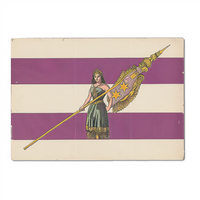
| |
| The first documented appearance of Aurelia, in a postcard commemorating the creation of the Federation of Alduria-Wechua; by Cecilia Dennison; 1685 AN. | |
| Personification of Nouvelle Alexandrie | |
| Titles and Offices Held | |
| Full Name | Aurelia of Nouvelle Alexandrie |
| Parents | Lady Alexandria |
| Spouse | Padre Inti |
| Children | None |
| Birth Date | Symbolically, upon the creation of Alduria-Wechua; 1685 AN |
| Occupation | National symbol and inspirational figure |
| National Origin | |
| Known For | Symbolizing the rebirth and aspirations of Nouvelle Alexandrie |
Lady Aurelia, also known as Chere Aurelia in Alexandrian, Aurelia Sumaq in Wechua, and La Aurelia in Martino, is the national personification of the Federation of Nouvelle Alexandrie, a symbolic figure representing the essence and aspirations of the nation as it continues the legacies of Alexandria, Hamland, Caputia, and the Wechua Nation. As the daughter of Lady Alexandria, the personification of the former Empire, and Padre Inti, Aurelia embodies the transition from the old glory to a renewed vision, bridging the federation's historic roots with progressive ideals.
History
The concept of Aurelia was developed through a collaborative effort, but the first documented depiction was created by Cecilia Dennison, an Aldurian artist based in Punta Santiago, in 1686 AN. She was commissioned by the Arts and Culture Commission (ArtCo), which was established under the New Prosperity Plan in 1685 AN to foster a shared cultural identity and promote the newly formed Federation of Alduria-Wechua.
The initiative for Aurelia's creation began with the Committee for Alduro-Wechu Integration, formed in 1685 AN after five years of diplomatic and political negotiations between the Republic of Alduria and the Wechua Nation. These discussions aimed to unify the two nations into a single federation, enhancing their close cultural, economic, and political ties. Prominent officials, including Alejandro Campos, advocated for the development of cultural and artistic symbols to promote the benefits of federation to the public and facilitate cultural integration.
The culmination of these efforts was marked by the Cabildo de Cárdenas issuing the Proclamation of Punta Santiago, which officially established the Federation of Alduria-Wechua on 12.XV.1685 AN. Alejandro Campos was appointed as the first President of the Government, also known as Premier. He was instrumental in establishing the ArtCo as part of his broader New Prosperity Plan, with the specific mandate to employ artists from diverse disciplines—painting, sculpture, writing, and architecture. These artists were tasked with creating public artworks that encapsulated the Federation’s ideals of unity, justice, and inclusion.
According to directives issued in late 1686 AN, these artworks were intended to foster trust in federal institutions and honor all cultures within the Federation. They were to reflect themes of inclusion, justice, and the "collective power of the Federation's free, industrious, and prosperous individuals." This directive was strongly supported by King of Nouvelle Alexandrie, Manco Capac, who emphasized these themes in the Order-in-Council that implemented the plan.
Evolution and Acceptance
Over the years, Aurelia grew from a mere concept into a significant cultural icon within Nouvelle Alexandrie. Her image was widely disseminated through various media as part of the ArtCo's initiatives. Public statues, murals, and multimedia presentations across the Federation depicted Aurelia as a unifying figure, embodying the aspirations and diversity of her people. ArtCo's continued funding and support led to Aurelia's presence in national education curricula, where she was integrated into history and social studies programs. This educational integration helped solidify her status as a foundational symbol of national identity, particularly among the younger generations.
As the Federation expanded and diversified, Aurelia's representations evolved to include elements from newer member cultures, ensuring her image remained inclusive and representative of the entire Federation's populace. This adaptability has been key to her enduring presence and relevance in the national consciousness.
Characteristics and Symbolism
Aurelia embodies the cultural and spiritual elements that reflect the diverse heritage of Nouvelle Alexandrie. Besides her youthful and dignified appearance and flowing robes, Aurelia is frequently depicted with a phoenix, a prominent symbol found on the flag of Nouvelle Alexandrie. This mythical bird represents rebirth, renewal, and eternal continuity, resonating with Nouvelle Alexandrie’s historical resilience and aspirational future. The phoenix in Aurelia's depictions is not merely an ornamental addition but serves as a profound emblem of the nation's ability to rise anew from the ashes of its past. This powerful imagery is particularly evocative given Nouvelle Alexandrie's national narrative of rebirth following the legacies of Alexandria, Caputia, and the Wechua Nation.
In addition to the phoenix, the presence of a stylized sun in Aurelia’s iconography is significant. This sun symbolizes the blessing and presence of the god Inti, revered in the Wechua Nation. The sun's inclusion in Aurelia’s depictions links her not only to the national identity but also to the spiritual life of the people, intertwining the Faith of Inti into the broader narrative of national personification. The sun, often represented as radiating light from Aurelia's hand or incorporated into the background of her portrayals, is a source of life and energy. It underscores themes of growth, warmth, and divine protection.
Name
The name "Aurelia" is derived from the Audente word "aureus," meaning "golden"[1]. During the development of Aurelia, several other names were considered, such as Margarita, Lady Fenix, among others. The name "Aurelia" was eventually chosen by the Arts and Culture Commission, because it was seen to evoke a sense of worth, brilliance, and enduring value. This name was selected to signify a new era of prosperity and enlightenment for both Alduria and the Wechua Nation. The name also acts as both a reference to the vast wealth and riches of Alexandria, which for centuries dominated the large gold deposits in Cibola, and to the legacy of Aurelia's father, the god Inti himself. In this context, the name Aurelia not only a reference to historical and cultural legacies, but it also is meant to symbolize a bright, prosperous future.
- Examples of Famous Depictions of Aurelia
"Lady Aurelia", the first known depiction of Aurelia, drawn by Cecilia Dennison. Became a wildly successful and popular postcard that introduced Aurelia to the country.
(1686 AN)."Empress Aurelia, Salvanos", a postcard drawn by Cecilia Dennison celebrating the (then) 10 Regions of Nouvelle Alexandrie.
(1698 AN)"Lady Aurelia with the Wings of the Phoenix", a postcard drawn by Cecilia Dennison. This was meant to reference her first postcard, but showing Aurelia as a ruler.
(1699 AN)"La Aurelia de los Ejercitos de Gloria" ("Aurelia of the Armies of Glory"), painted by Pedro de la Garza around the time of Operation Purple Splendor.
(1718 AN)An untitled painting in the Legislative Palace depicting Aurelia; by Casimiro Montesinos.
(1699 AN)"Aurelia de Todos", a large sculpture located at the Parque de los Niños in Parap, Wechua Nation. The child represents the children of the federation; by Alejandro Venegas.
(1697 AN)- "La Mujer de Oro", a bust of Aurelia by Gery Balsdenberg representing the prosperity and industriousness of the federation.
(1728 AN) "Go To Lyrica, Young Man - Follow Her!", a propaganda poster by Louis Xavier featuring Aurelia, promoting the Lyrican Settlement Company and its efforts to settle in the new Regions of North Lyrica and South Lyrica.
(1703 AN)"Rise to Defend Her!", a military recruitment poster by Louis Xavier featuring Aurelia.
(1719 AN)
Role in Society
HMS Aurelia
Cultural Impact
Legacy and Continuity
See Also
- New Prosperity Plan
- Cecilia Dennison
- Alejandro Campos
- King Manco Capac I
- Symbols of Nouvelle Alexandrie
- HMS Aurelia
References
- ^ “Jill Scott - Golden.” YouTube, YouTube, 13 Aug. 2007, www.youtube.com/watch?v=4QCXr79Rkcw.
